THH3113 Cost & Performance Management for Tourism: Radisson Blu
VerifiedAdded on 2023/06/08
|8
|2259
|79
Report
AI Summary
This report provides a detailed analysis of cost and performance management within the context of Radisson Blu Plaza Hotel Sydney. It identifies key cost drivers, differentiating between fixed and variable costs, and examines their impact on the hotel's financial performance. The report includes a break-even analysis, calculating the number of rooms and revenue required to cover all expenses, and explores target profit implementation strategies, comparing different options for achieving specific profit goals. The analysis considers factors such as labor costs, utilities, marketing expenses, and insurance, ultimately recommending a strategy that maximizes revenue potential and operational efficiency for the hotel during its peak season. This document is available on Desklib, a platform offering a wide range of academic resources for students.
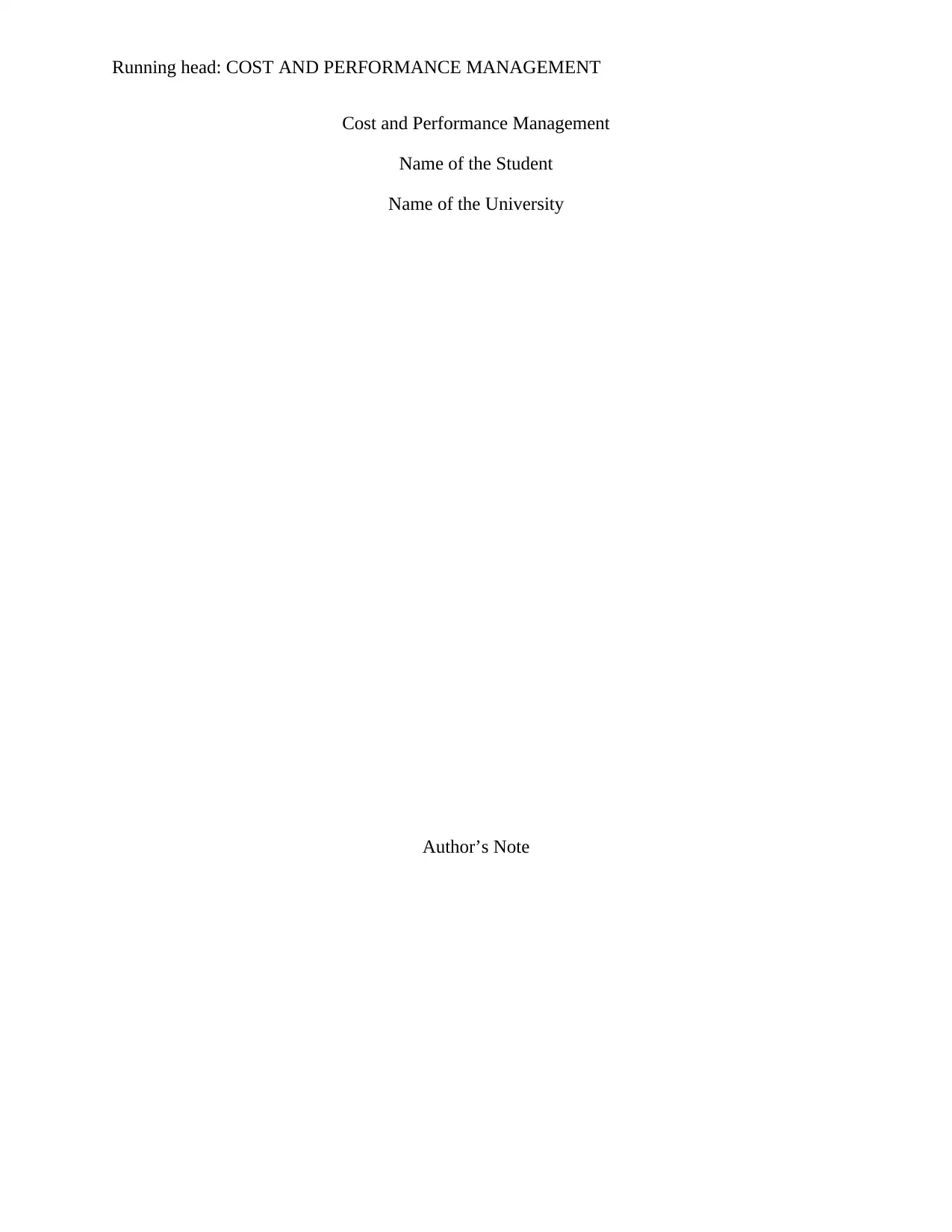
Running head: COST AND PERFORMANCE MANAGEMENT
Cost and Performance Management
Name of the Student
Name of the University
Author’s Note
Cost and Performance Management
Name of the Student
Name of the University
Author’s Note
Paraphrase This Document
Need a fresh take? Get an instant paraphrase of this document with our AI Paraphraser
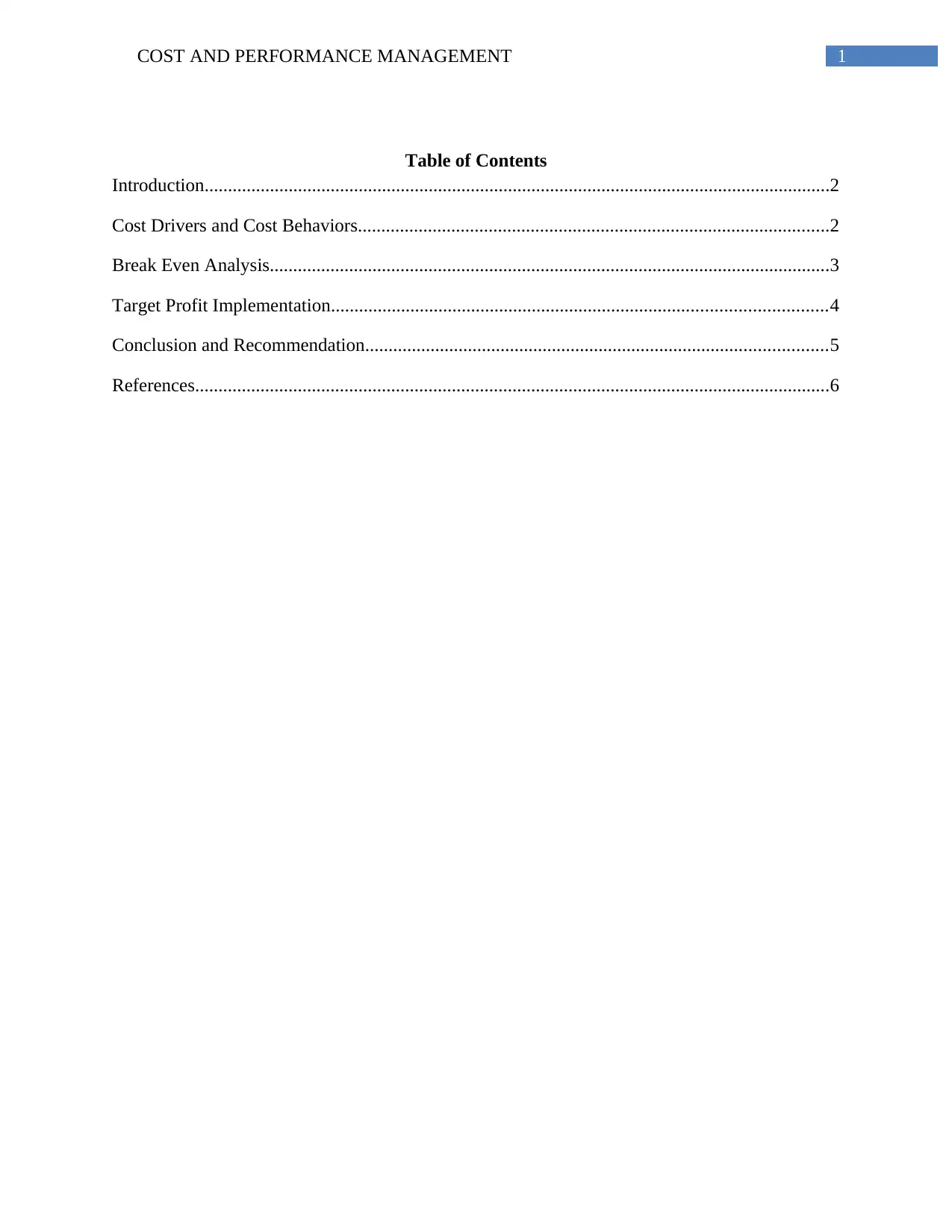
1COST AND PERFORMANCE MANAGEMENT
Table of Contents
Introduction......................................................................................................................................2
Cost Drivers and Cost Behaviors.....................................................................................................2
Break Even Analysis........................................................................................................................3
Target Profit Implementation..........................................................................................................4
Conclusion and Recommendation...................................................................................................5
References........................................................................................................................................6
Table of Contents
Introduction......................................................................................................................................2
Cost Drivers and Cost Behaviors.....................................................................................................2
Break Even Analysis........................................................................................................................3
Target Profit Implementation..........................................................................................................4
Conclusion and Recommendation...................................................................................................5
References........................................................................................................................................6
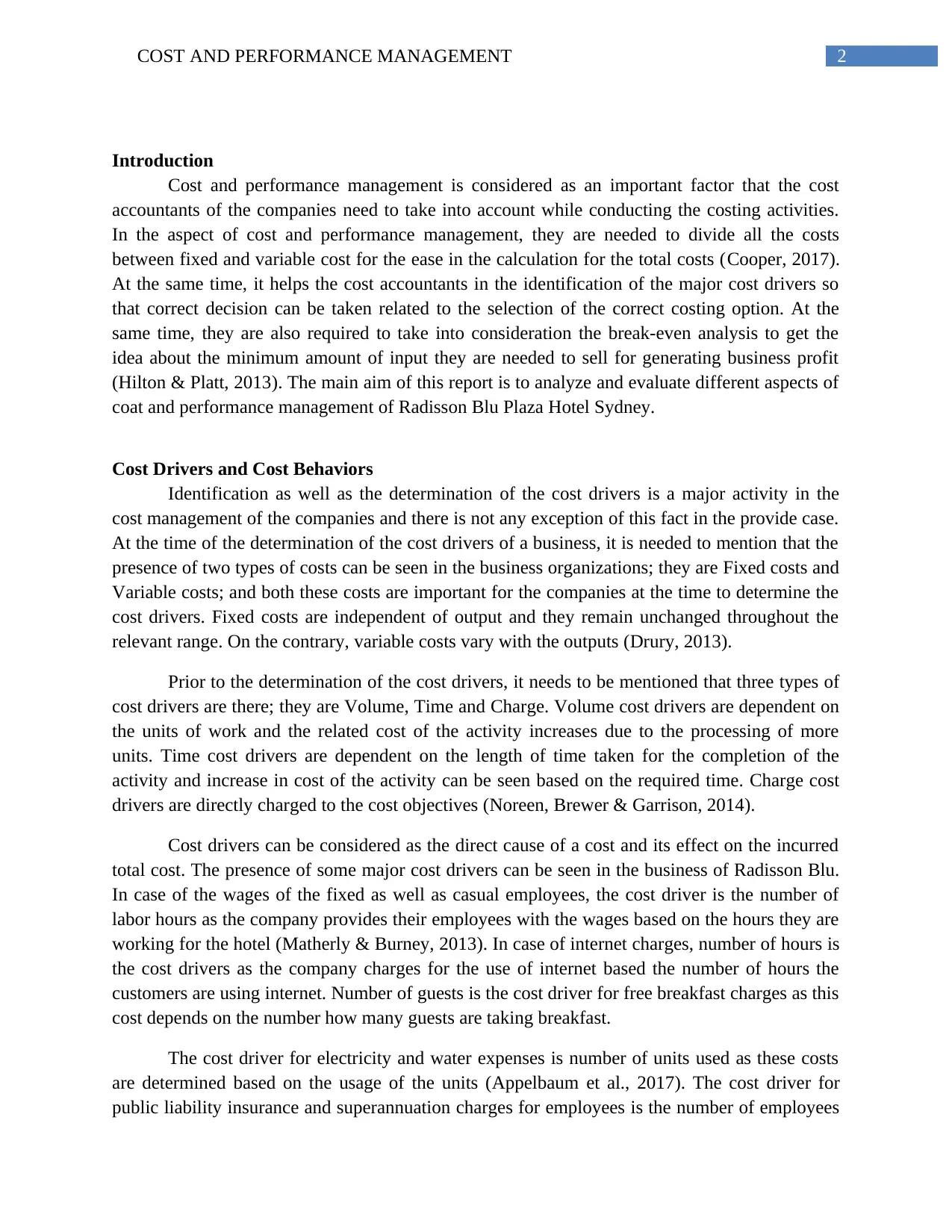
2COST AND PERFORMANCE MANAGEMENT
Introduction
Cost and performance management is considered as an important factor that the cost
accountants of the companies need to take into account while conducting the costing activities.
In the aspect of cost and performance management, they are needed to divide all the costs
between fixed and variable cost for the ease in the calculation for the total costs (Cooper, 2017).
At the same time, it helps the cost accountants in the identification of the major cost drivers so
that correct decision can be taken related to the selection of the correct costing option. At the
same time, they are also required to take into consideration the break-even analysis to get the
idea about the minimum amount of input they are needed to sell for generating business profit
(Hilton & Platt, 2013). The main aim of this report is to analyze and evaluate different aspects of
coat and performance management of Radisson Blu Plaza Hotel Sydney.
Cost Drivers and Cost Behaviors
Identification as well as the determination of the cost drivers is a major activity in the
cost management of the companies and there is not any exception of this fact in the provide case.
At the time of the determination of the cost drivers of a business, it is needed to mention that the
presence of two types of costs can be seen in the business organizations; they are Fixed costs and
Variable costs; and both these costs are important for the companies at the time to determine the
cost drivers. Fixed costs are independent of output and they remain unchanged throughout the
relevant range. On the contrary, variable costs vary with the outputs (Drury, 2013).
Prior to the determination of the cost drivers, it needs to be mentioned that three types of
cost drivers are there; they are Volume, Time and Charge. Volume cost drivers are dependent on
the units of work and the related cost of the activity increases due to the processing of more
units. Time cost drivers are dependent on the length of time taken for the completion of the
activity and increase in cost of the activity can be seen based on the required time. Charge cost
drivers are directly charged to the cost objectives (Noreen, Brewer & Garrison, 2014).
Cost drivers can be considered as the direct cause of a cost and its effect on the incurred
total cost. The presence of some major cost drivers can be seen in the business of Radisson Blu.
In case of the wages of the fixed as well as casual employees, the cost driver is the number of
labor hours as the company provides their employees with the wages based on the hours they are
working for the hotel (Matherly & Burney, 2013). In case of internet charges, number of hours is
the cost drivers as the company charges for the use of internet based the number of hours the
customers are using internet. Number of guests is the cost driver for free breakfast charges as this
cost depends on the number how many guests are taking breakfast.
The cost driver for electricity and water expenses is number of units used as these costs
are determined based on the usage of the units (Appelbaum et al., 2017). The cost driver for
public liability insurance and superannuation charges for employees is the number of employees
Introduction
Cost and performance management is considered as an important factor that the cost
accountants of the companies need to take into account while conducting the costing activities.
In the aspect of cost and performance management, they are needed to divide all the costs
between fixed and variable cost for the ease in the calculation for the total costs (Cooper, 2017).
At the same time, it helps the cost accountants in the identification of the major cost drivers so
that correct decision can be taken related to the selection of the correct costing option. At the
same time, they are also required to take into consideration the break-even analysis to get the
idea about the minimum amount of input they are needed to sell for generating business profit
(Hilton & Platt, 2013). The main aim of this report is to analyze and evaluate different aspects of
coat and performance management of Radisson Blu Plaza Hotel Sydney.
Cost Drivers and Cost Behaviors
Identification as well as the determination of the cost drivers is a major activity in the
cost management of the companies and there is not any exception of this fact in the provide case.
At the time of the determination of the cost drivers of a business, it is needed to mention that the
presence of two types of costs can be seen in the business organizations; they are Fixed costs and
Variable costs; and both these costs are important for the companies at the time to determine the
cost drivers. Fixed costs are independent of output and they remain unchanged throughout the
relevant range. On the contrary, variable costs vary with the outputs (Drury, 2013).
Prior to the determination of the cost drivers, it needs to be mentioned that three types of
cost drivers are there; they are Volume, Time and Charge. Volume cost drivers are dependent on
the units of work and the related cost of the activity increases due to the processing of more
units. Time cost drivers are dependent on the length of time taken for the completion of the
activity and increase in cost of the activity can be seen based on the required time. Charge cost
drivers are directly charged to the cost objectives (Noreen, Brewer & Garrison, 2014).
Cost drivers can be considered as the direct cause of a cost and its effect on the incurred
total cost. The presence of some major cost drivers can be seen in the business of Radisson Blu.
In case of the wages of the fixed as well as casual employees, the cost driver is the number of
labor hours as the company provides their employees with the wages based on the hours they are
working for the hotel (Matherly & Burney, 2013). In case of internet charges, number of hours is
the cost drivers as the company charges for the use of internet based the number of hours the
customers are using internet. Number of guests is the cost driver for free breakfast charges as this
cost depends on the number how many guests are taking breakfast.
The cost driver for electricity and water expenses is number of units used as these costs
are determined based on the usage of the units (Appelbaum et al., 2017). The cost driver for
public liability insurance and superannuation charges for employees is the number of employees
⊘ This is a preview!⊘
Do you want full access?
Subscribe today to unlock all pages.

Trusted by 1+ million students worldwide
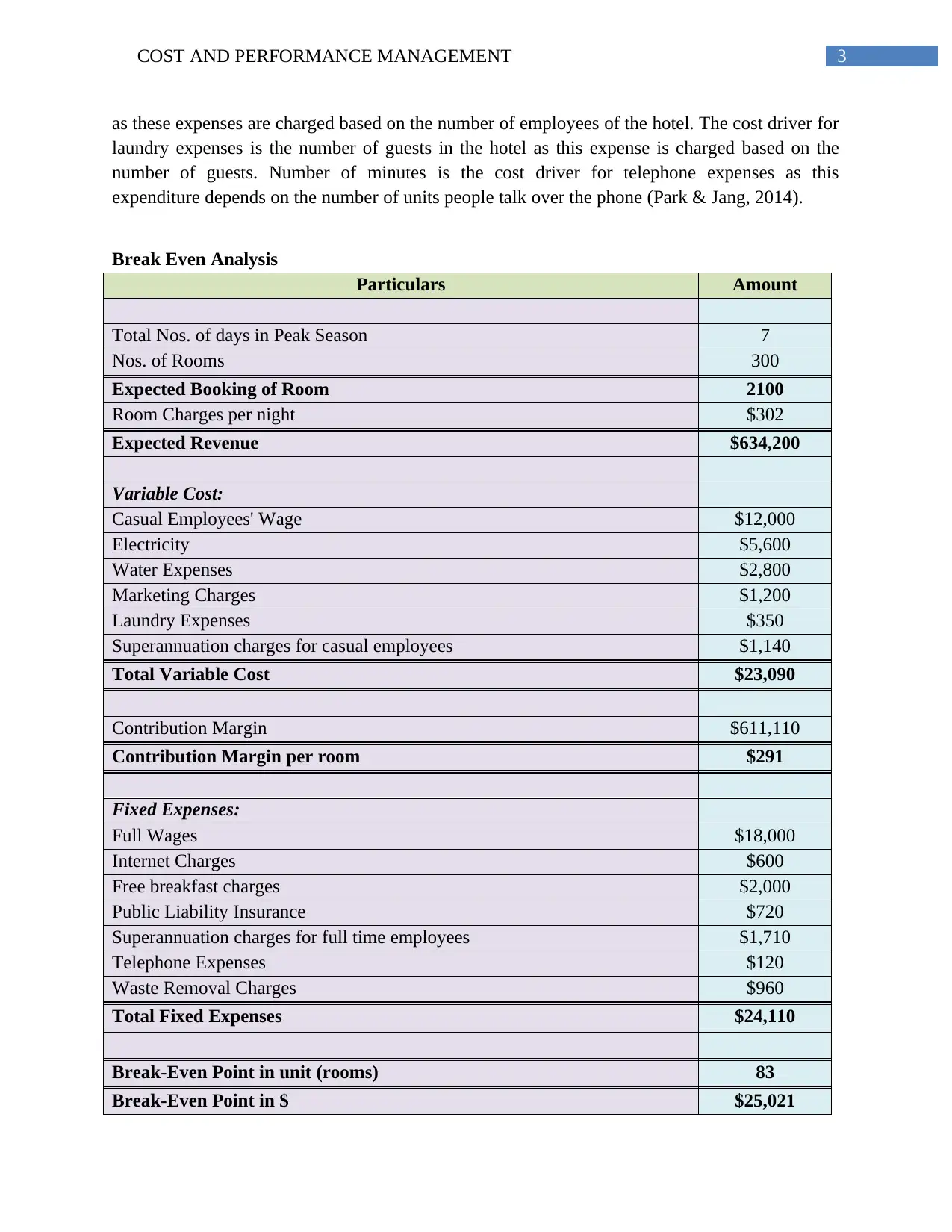
3COST AND PERFORMANCE MANAGEMENT
as these expenses are charged based on the number of employees of the hotel. The cost driver for
laundry expenses is the number of guests in the hotel as this expense is charged based on the
number of guests. Number of minutes is the cost driver for telephone expenses as this
expenditure depends on the number of units people talk over the phone (Park & Jang, 2014).
Break Even Analysis
Particulars Amount
Total Nos. of days in Peak Season 7
Nos. of Rooms 300
Expected Booking of Room 2100
Room Charges per night $302
Expected Revenue $634,200
Variable Cost:
Casual Employees' Wage $12,000
Electricity $5,600
Water Expenses $2,800
Marketing Charges $1,200
Laundry Expenses $350
Superannuation charges for casual employees $1,140
Total Variable Cost $23,090
Contribution Margin $611,110
Contribution Margin per room $291
Fixed Expenses:
Full Wages $18,000
Internet Charges $600
Free breakfast charges $2,000
Public Liability Insurance $720
Superannuation charges for full time employees $1,710
Telephone Expenses $120
Waste Removal Charges $960
Total Fixed Expenses $24,110
Break-Even Point in unit (rooms) 83
Break-Even Point in $ $25,021
as these expenses are charged based on the number of employees of the hotel. The cost driver for
laundry expenses is the number of guests in the hotel as this expense is charged based on the
number of guests. Number of minutes is the cost driver for telephone expenses as this
expenditure depends on the number of units people talk over the phone (Park & Jang, 2014).
Break Even Analysis
Particulars Amount
Total Nos. of days in Peak Season 7
Nos. of Rooms 300
Expected Booking of Room 2100
Room Charges per night $302
Expected Revenue $634,200
Variable Cost:
Casual Employees' Wage $12,000
Electricity $5,600
Water Expenses $2,800
Marketing Charges $1,200
Laundry Expenses $350
Superannuation charges for casual employees $1,140
Total Variable Cost $23,090
Contribution Margin $611,110
Contribution Margin per room $291
Fixed Expenses:
Full Wages $18,000
Internet Charges $600
Free breakfast charges $2,000
Public Liability Insurance $720
Superannuation charges for full time employees $1,710
Telephone Expenses $120
Waste Removal Charges $960
Total Fixed Expenses $24,110
Break-Even Point in unit (rooms) 83
Break-Even Point in $ $25,021
Paraphrase This Document
Need a fresh take? Get an instant paraphrase of this document with our AI Paraphraser
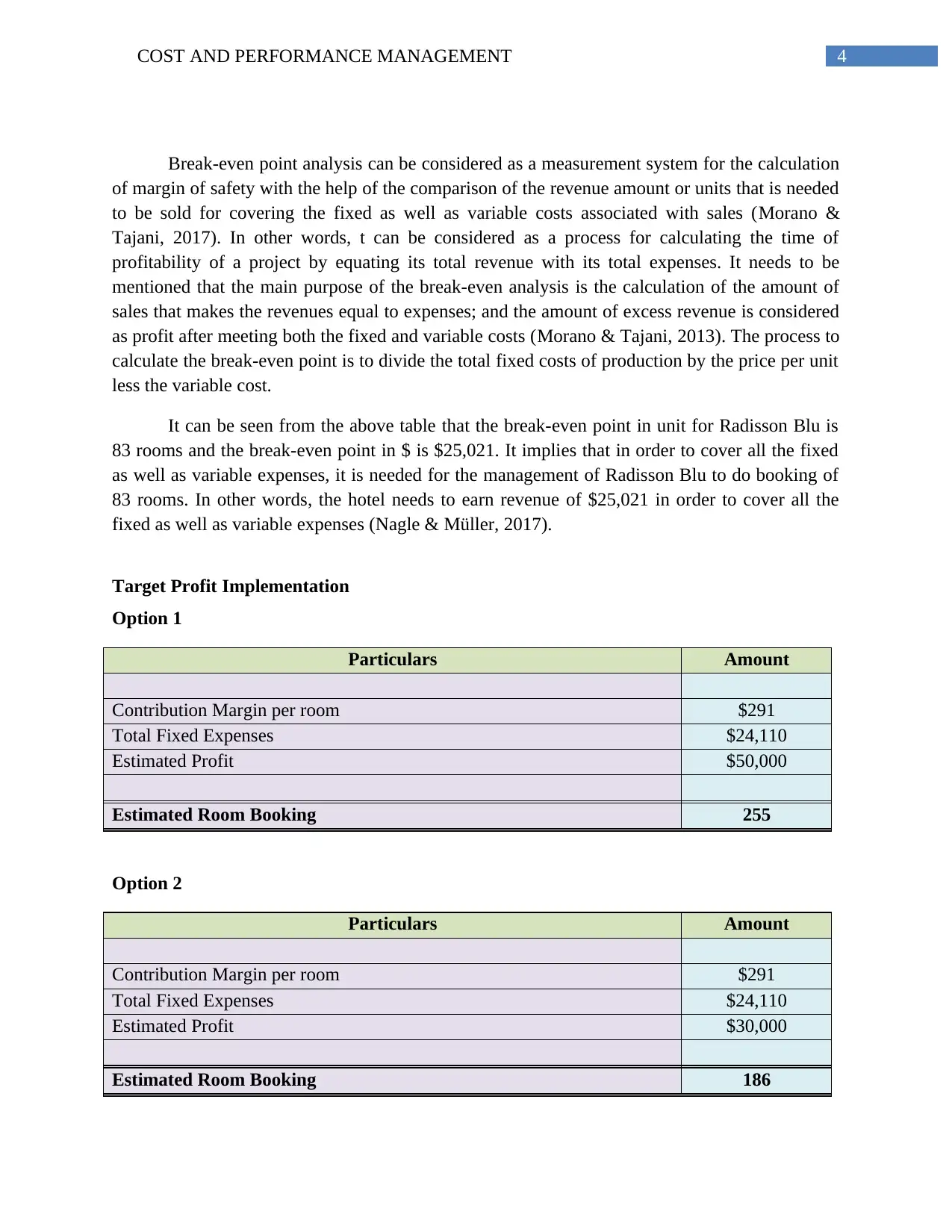
4COST AND PERFORMANCE MANAGEMENT
Break-even point analysis can be considered as a measurement system for the calculation
of margin of safety with the help of the comparison of the revenue amount or units that is needed
to be sold for covering the fixed as well as variable costs associated with sales (Morano &
Tajani, 2017). In other words, t can be considered as a process for calculating the time of
profitability of a project by equating its total revenue with its total expenses. It needs to be
mentioned that the main purpose of the break-even analysis is the calculation of the amount of
sales that makes the revenues equal to expenses; and the amount of excess revenue is considered
as profit after meeting both the fixed and variable costs (Morano & Tajani, 2013). The process to
calculate the break-even point is to divide the total fixed costs of production by the price per unit
less the variable cost.
It can be seen from the above table that the break-even point in unit for Radisson Blu is
83 rooms and the break-even point in $ is $25,021. It implies that in order to cover all the fixed
as well as variable expenses, it is needed for the management of Radisson Blu to do booking of
83 rooms. In other words, the hotel needs to earn revenue of $25,021 in order to cover all the
fixed as well as variable expenses (Nagle & Müller, 2017).
Target Profit Implementation
Option 1
Particulars Amount
Contribution Margin per room $291
Total Fixed Expenses $24,110
Estimated Profit $50,000
Estimated Room Booking 255
Option 2
Particulars Amount
Contribution Margin per room $291
Total Fixed Expenses $24,110
Estimated Profit $30,000
Estimated Room Booking 186
Break-even point analysis can be considered as a measurement system for the calculation
of margin of safety with the help of the comparison of the revenue amount or units that is needed
to be sold for covering the fixed as well as variable costs associated with sales (Morano &
Tajani, 2017). In other words, t can be considered as a process for calculating the time of
profitability of a project by equating its total revenue with its total expenses. It needs to be
mentioned that the main purpose of the break-even analysis is the calculation of the amount of
sales that makes the revenues equal to expenses; and the amount of excess revenue is considered
as profit after meeting both the fixed and variable costs (Morano & Tajani, 2013). The process to
calculate the break-even point is to divide the total fixed costs of production by the price per unit
less the variable cost.
It can be seen from the above table that the break-even point in unit for Radisson Blu is
83 rooms and the break-even point in $ is $25,021. It implies that in order to cover all the fixed
as well as variable expenses, it is needed for the management of Radisson Blu to do booking of
83 rooms. In other words, the hotel needs to earn revenue of $25,021 in order to cover all the
fixed as well as variable expenses (Nagle & Müller, 2017).
Target Profit Implementation
Option 1
Particulars Amount
Contribution Margin per room $291
Total Fixed Expenses $24,110
Estimated Profit $50,000
Estimated Room Booking 255
Option 2
Particulars Amount
Contribution Margin per room $291
Total Fixed Expenses $24,110
Estimated Profit $30,000
Estimated Room Booking 186
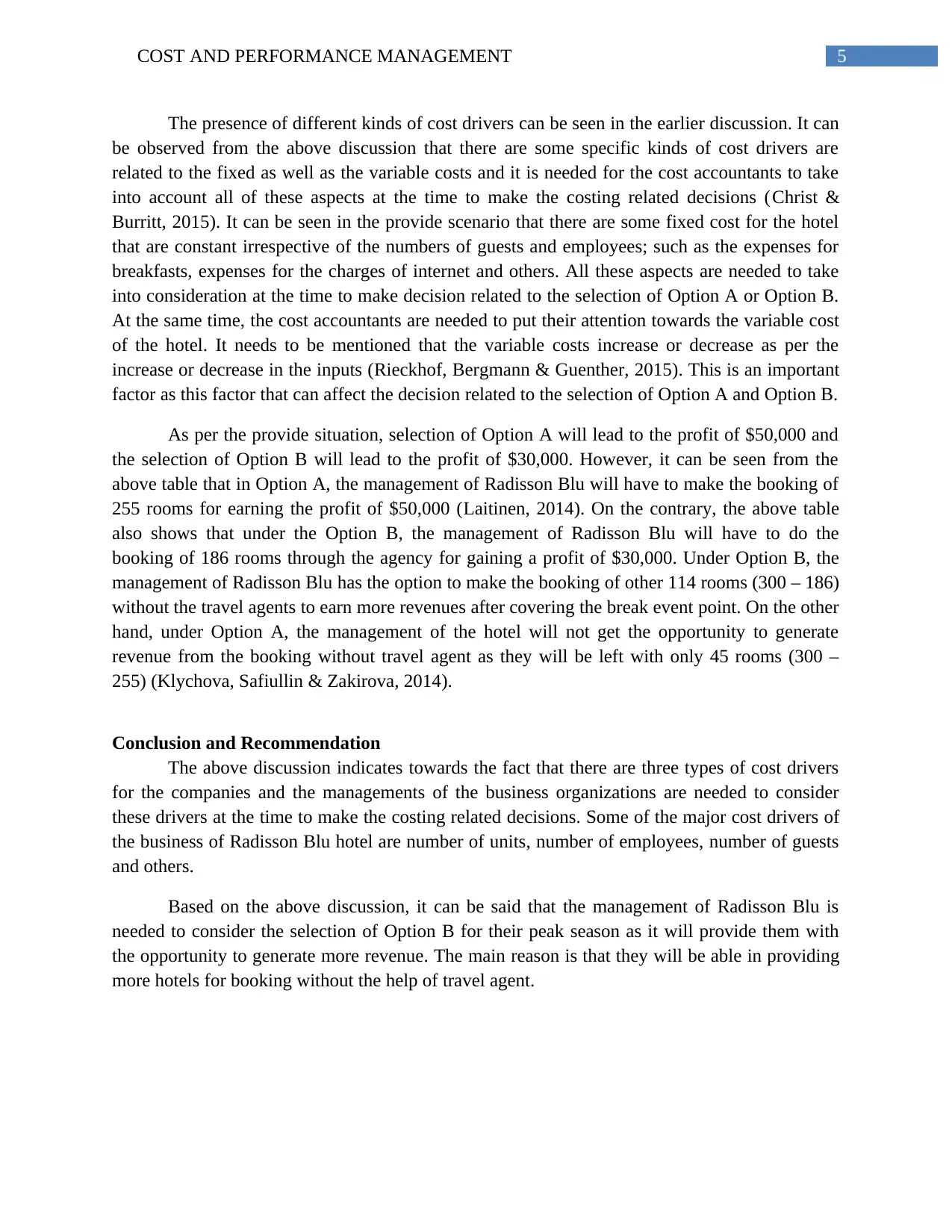
5COST AND PERFORMANCE MANAGEMENT
The presence of different kinds of cost drivers can be seen in the earlier discussion. It can
be observed from the above discussion that there are some specific kinds of cost drivers are
related to the fixed as well as the variable costs and it is needed for the cost accountants to take
into account all of these aspects at the time to make the costing related decisions (Christ &
Burritt, 2015). It can be seen in the provide scenario that there are some fixed cost for the hotel
that are constant irrespective of the numbers of guests and employees; such as the expenses for
breakfasts, expenses for the charges of internet and others. All these aspects are needed to take
into consideration at the time to make decision related to the selection of Option A or Option B.
At the same time, the cost accountants are needed to put their attention towards the variable cost
of the hotel. It needs to be mentioned that the variable costs increase or decrease as per the
increase or decrease in the inputs (Rieckhof, Bergmann & Guenther, 2015). This is an important
factor as this factor that can affect the decision related to the selection of Option A and Option B.
As per the provide situation, selection of Option A will lead to the profit of $50,000 and
the selection of Option B will lead to the profit of $30,000. However, it can be seen from the
above table that in Option A, the management of Radisson Blu will have to make the booking of
255 rooms for earning the profit of $50,000 (Laitinen, 2014). On the contrary, the above table
also shows that under the Option B, the management of Radisson Blu will have to do the
booking of 186 rooms through the agency for gaining a profit of $30,000. Under Option B, the
management of Radisson Blu has the option to make the booking of other 114 rooms (300 – 186)
without the travel agents to earn more revenues after covering the break event point. On the other
hand, under Option A, the management of the hotel will not get the opportunity to generate
revenue from the booking without travel agent as they will be left with only 45 rooms (300 –
255) (Klychova, Safiullin & Zakirova, 2014).
Conclusion and Recommendation
The above discussion indicates towards the fact that there are three types of cost drivers
for the companies and the managements of the business organizations are needed to consider
these drivers at the time to make the costing related decisions. Some of the major cost drivers of
the business of Radisson Blu hotel are number of units, number of employees, number of guests
and others.
Based on the above discussion, it can be said that the management of Radisson Blu is
needed to consider the selection of Option B for their peak season as it will provide them with
the opportunity to generate more revenue. The main reason is that they will be able in providing
more hotels for booking without the help of travel agent.
The presence of different kinds of cost drivers can be seen in the earlier discussion. It can
be observed from the above discussion that there are some specific kinds of cost drivers are
related to the fixed as well as the variable costs and it is needed for the cost accountants to take
into account all of these aspects at the time to make the costing related decisions (Christ &
Burritt, 2015). It can be seen in the provide scenario that there are some fixed cost for the hotel
that are constant irrespective of the numbers of guests and employees; such as the expenses for
breakfasts, expenses for the charges of internet and others. All these aspects are needed to take
into consideration at the time to make decision related to the selection of Option A or Option B.
At the same time, the cost accountants are needed to put their attention towards the variable cost
of the hotel. It needs to be mentioned that the variable costs increase or decrease as per the
increase or decrease in the inputs (Rieckhof, Bergmann & Guenther, 2015). This is an important
factor as this factor that can affect the decision related to the selection of Option A and Option B.
As per the provide situation, selection of Option A will lead to the profit of $50,000 and
the selection of Option B will lead to the profit of $30,000. However, it can be seen from the
above table that in Option A, the management of Radisson Blu will have to make the booking of
255 rooms for earning the profit of $50,000 (Laitinen, 2014). On the contrary, the above table
also shows that under the Option B, the management of Radisson Blu will have to do the
booking of 186 rooms through the agency for gaining a profit of $30,000. Under Option B, the
management of Radisson Blu has the option to make the booking of other 114 rooms (300 – 186)
without the travel agents to earn more revenues after covering the break event point. On the other
hand, under Option A, the management of the hotel will not get the opportunity to generate
revenue from the booking without travel agent as they will be left with only 45 rooms (300 –
255) (Klychova, Safiullin & Zakirova, 2014).
Conclusion and Recommendation
The above discussion indicates towards the fact that there are three types of cost drivers
for the companies and the managements of the business organizations are needed to consider
these drivers at the time to make the costing related decisions. Some of the major cost drivers of
the business of Radisson Blu hotel are number of units, number of employees, number of guests
and others.
Based on the above discussion, it can be said that the management of Radisson Blu is
needed to consider the selection of Option B for their peak season as it will provide them with
the opportunity to generate more revenue. The main reason is that they will be able in providing
more hotels for booking without the help of travel agent.
⊘ This is a preview!⊘
Do you want full access?
Subscribe today to unlock all pages.

Trusted by 1+ million students worldwide
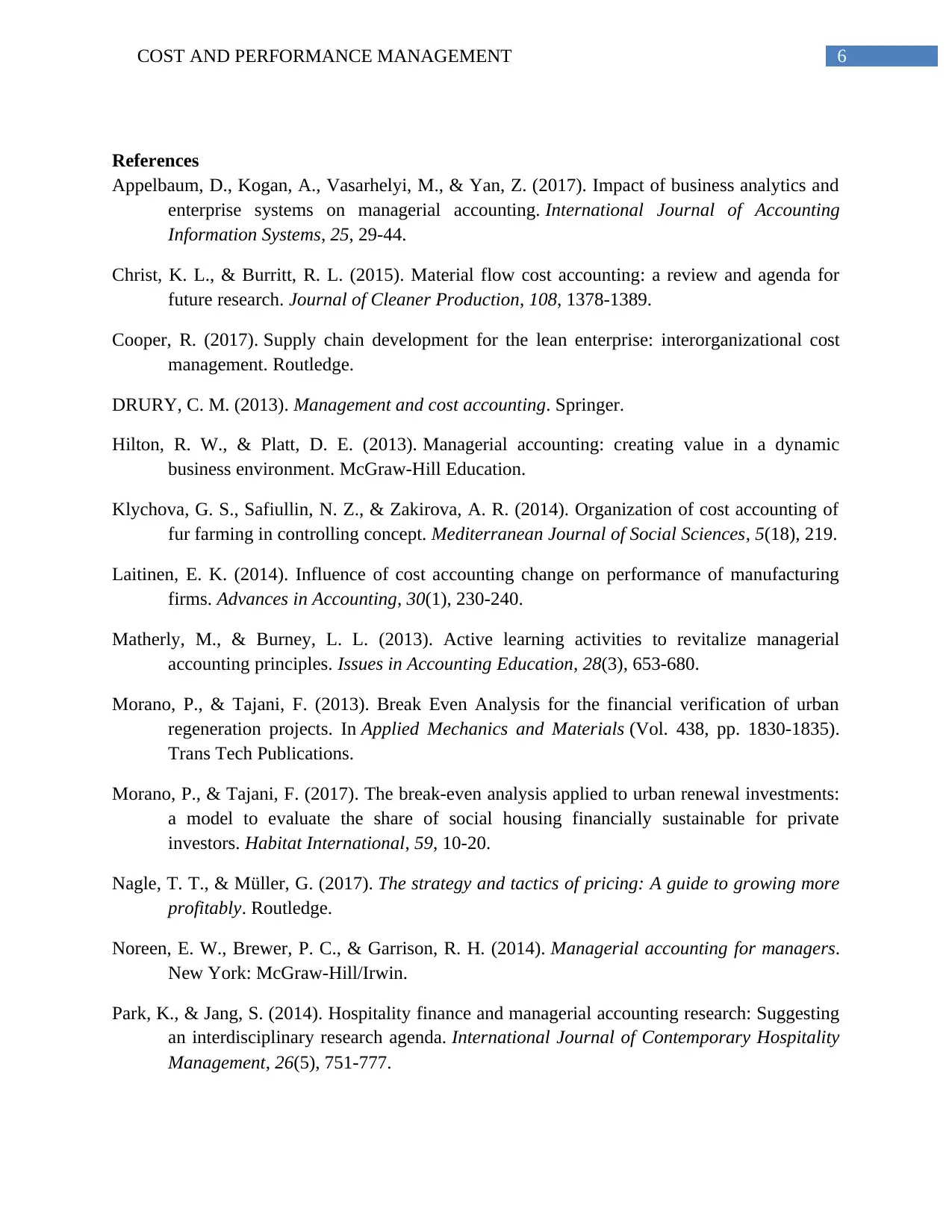
6COST AND PERFORMANCE MANAGEMENT
References
Appelbaum, D., Kogan, A., Vasarhelyi, M., & Yan, Z. (2017). Impact of business analytics and
enterprise systems on managerial accounting. International Journal of Accounting
Information Systems, 25, 29-44.
Christ, K. L., & Burritt, R. L. (2015). Material flow cost accounting: a review and agenda for
future research. Journal of Cleaner Production, 108, 1378-1389.
Cooper, R. (2017). Supply chain development for the lean enterprise: interorganizational cost
management. Routledge.
DRURY, C. M. (2013). Management and cost accounting. Springer.
Hilton, R. W., & Platt, D. E. (2013). Managerial accounting: creating value in a dynamic
business environment. McGraw-Hill Education.
Klychova, G. S., Safiullin, N. Z., & Zakirova, A. R. (2014). Organization of cost accounting of
fur farming in controlling concept. Mediterranean Journal of Social Sciences, 5(18), 219.
Laitinen, E. K. (2014). Influence of cost accounting change on performance of manufacturing
firms. Advances in Accounting, 30(1), 230-240.
Matherly, M., & Burney, L. L. (2013). Active learning activities to revitalize managerial
accounting principles. Issues in Accounting Education, 28(3), 653-680.
Morano, P., & Tajani, F. (2013). Break Even Analysis for the financial verification of urban
regeneration projects. In Applied Mechanics and Materials (Vol. 438, pp. 1830-1835).
Trans Tech Publications.
Morano, P., & Tajani, F. (2017). The break-even analysis applied to urban renewal investments:
a model to evaluate the share of social housing financially sustainable for private
investors. Habitat International, 59, 10-20.
Nagle, T. T., & Müller, G. (2017). The strategy and tactics of pricing: A guide to growing more
profitably. Routledge.
Noreen, E. W., Brewer, P. C., & Garrison, R. H. (2014). Managerial accounting for managers.
New York: McGraw-Hill/Irwin.
Park, K., & Jang, S. (2014). Hospitality finance and managerial accounting research: Suggesting
an interdisciplinary research agenda. International Journal of Contemporary Hospitality
Management, 26(5), 751-777.
References
Appelbaum, D., Kogan, A., Vasarhelyi, M., & Yan, Z. (2017). Impact of business analytics and
enterprise systems on managerial accounting. International Journal of Accounting
Information Systems, 25, 29-44.
Christ, K. L., & Burritt, R. L. (2015). Material flow cost accounting: a review and agenda for
future research. Journal of Cleaner Production, 108, 1378-1389.
Cooper, R. (2017). Supply chain development for the lean enterprise: interorganizational cost
management. Routledge.
DRURY, C. M. (2013). Management and cost accounting. Springer.
Hilton, R. W., & Platt, D. E. (2013). Managerial accounting: creating value in a dynamic
business environment. McGraw-Hill Education.
Klychova, G. S., Safiullin, N. Z., & Zakirova, A. R. (2014). Organization of cost accounting of
fur farming in controlling concept. Mediterranean Journal of Social Sciences, 5(18), 219.
Laitinen, E. K. (2014). Influence of cost accounting change on performance of manufacturing
firms. Advances in Accounting, 30(1), 230-240.
Matherly, M., & Burney, L. L. (2013). Active learning activities to revitalize managerial
accounting principles. Issues in Accounting Education, 28(3), 653-680.
Morano, P., & Tajani, F. (2013). Break Even Analysis for the financial verification of urban
regeneration projects. In Applied Mechanics and Materials (Vol. 438, pp. 1830-1835).
Trans Tech Publications.
Morano, P., & Tajani, F. (2017). The break-even analysis applied to urban renewal investments:
a model to evaluate the share of social housing financially sustainable for private
investors. Habitat International, 59, 10-20.
Nagle, T. T., & Müller, G. (2017). The strategy and tactics of pricing: A guide to growing more
profitably. Routledge.
Noreen, E. W., Brewer, P. C., & Garrison, R. H. (2014). Managerial accounting for managers.
New York: McGraw-Hill/Irwin.
Park, K., & Jang, S. (2014). Hospitality finance and managerial accounting research: Suggesting
an interdisciplinary research agenda. International Journal of Contemporary Hospitality
Management, 26(5), 751-777.
Paraphrase This Document
Need a fresh take? Get an instant paraphrase of this document with our AI Paraphraser
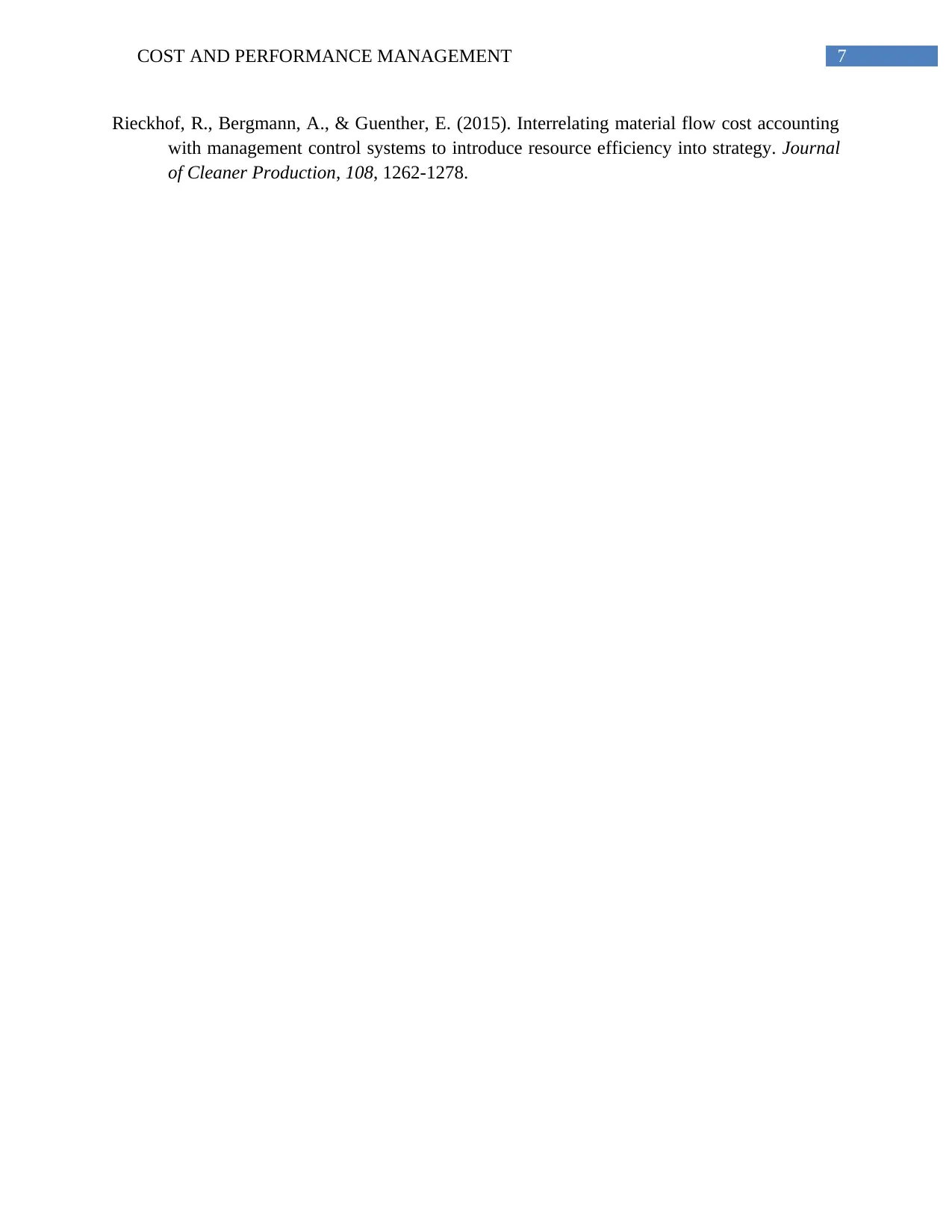
7COST AND PERFORMANCE MANAGEMENT
Rieckhof, R., Bergmann, A., & Guenther, E. (2015). Interrelating material flow cost accounting
with management control systems to introduce resource efficiency into strategy. Journal
of Cleaner Production, 108, 1262-1278.
Rieckhof, R., Bergmann, A., & Guenther, E. (2015). Interrelating material flow cost accounting
with management control systems to introduce resource efficiency into strategy. Journal
of Cleaner Production, 108, 1262-1278.
1 out of 8
Related Documents
Your All-in-One AI-Powered Toolkit for Academic Success.
+13062052269
info@desklib.com
Available 24*7 on WhatsApp / Email
![[object Object]](/_next/static/media/star-bottom.7253800d.svg)
Unlock your academic potential
Copyright © 2020–2025 A2Z Services. All Rights Reserved. Developed and managed by ZUCOL.





